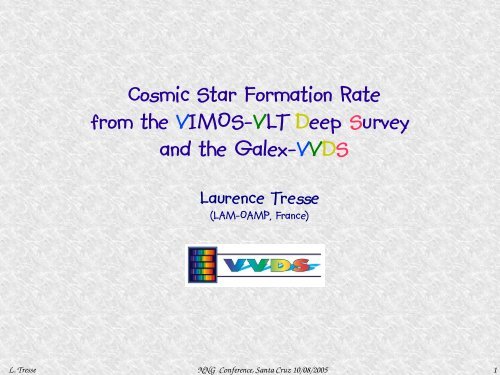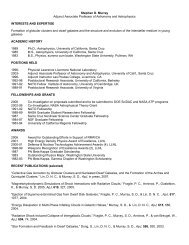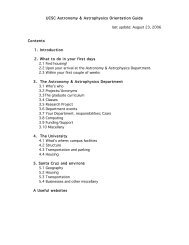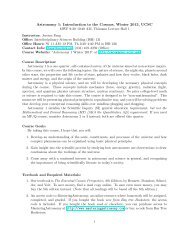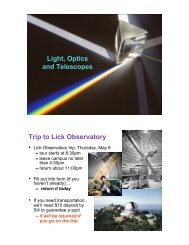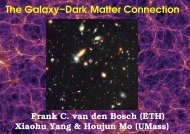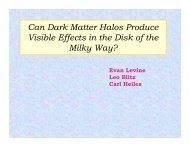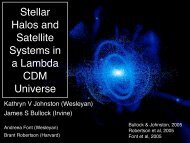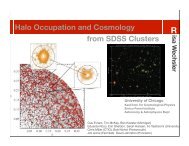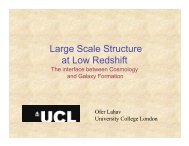Laurence Tresse
Laurence Tresse
Laurence Tresse
Create successful ePaper yourself
Turn your PDF publications into a flip-book with our unique Google optimized e-Paper software.
Cosmic Star Formation Rate<br />
from the VIMOS-VLT Deep Survey<br />
and the Galex-VVDS<br />
<strong>Laurence</strong> <strong>Tresse</strong><br />
(LAM-OAMP, France)<br />
L. <strong>Tresse</strong> NNG Conference, Santa Cruz 10/08/2005<br />
1
Hα<br />
UV<br />
Redshift Survey<br />
SFR, 1996<br />
Radi<br />
Sub-mm,IR<br />
o<br />
The SFR plot a decade before<br />
Madau et al. '96<br />
The questions were:<br />
Is there a peak at 1.3 < z < 2.7?<br />
By how much interstellar dust attenuates the UV light?<br />
Is it so steep at z
Recap of the VVDS main features<br />
VVDS-CDFS 0.1 deg 2<br />
HST BVIZ<br />
EIS UBVRI<br />
Spectroscopic redshift survey with VIMOS-ESO/VLT<br />
I-band selection VVDS-deep to I AB = 24.0 1.4 deg 2<br />
VVDS-wide to I AB = 22.5 10 deg 2<br />
LRred [5500-9500] Å, R=227, D=7.14 Å/pixel<br />
Exposure ~ 45 mn & 4.5 hours<br />
5 fields<br />
0230-04<br />
CDFS<br />
1000+03<br />
1400+05<br />
2217+00<br />
VVDS-0226-04 1.3 deg 2<br />
Multi-λ<br />
VVDS<br />
U(ESO-WFI) BVRI (CFHT-12K) Jks(ESO-SOFI), VLA 1.4 Ghz<br />
CFTLS Deep ugriz (Y. Mellier)<br />
GALEX NUV, FUV (C.Martin/B.Milliard)<br />
SPITZER-SWIRE NIR, FIR (C. Lonsdale)<br />
XMM (M. Pierre)<br />
4 x 7'x8' ~540 slits<br />
L. <strong>Tresse</strong> NNG Conference, Santa Cruz 10/08/2005<br />
3
The Redshift Distribution<br />
= 0.76 (median =0.9)<br />
Z = 0.0013<br />
First Epoch Data<br />
VVDS-0226-04 1700 arcmin 2 9842 spectra<br />
VVDS-CDFS 500 arcmin 2 1722 spectra<br />
Total = 11564 spectra<br />
Target Sampling rate ~25 %<br />
Q Q% Gal Stars QSO<br />
4 100% 1969 456 11<br />
3 95% 2495 141 27<br />
2 75% 2838 142 21<br />
9 SL 389 0 10<br />
1 50% 1438 64 14<br />
0 no z 744<br />
L. <strong>Tresse</strong> NNG Conference, Santa Cruz 10/08/2005<br />
4
I-selected VVDS & CFRS<br />
1.5 mag fainter, FOV 10 x larger<br />
B-band LFs<br />
Ilbert et al. '05 LF faint end slope<br />
Log(LD)<br />
Δ<br />
1.3<br />
CFRS 2.72±0.5<br />
VVDS 2.05±0.07<br />
Local point higher by ~0.1 in log<br />
At z small change in LD<br />
M* and φ * better constrained at z>0.7<br />
L. <strong>Tresse</strong> NNG Conference, Santa Cruz 10/08/2005<br />
5<br />
SDSS<br />
SAPM<br />
B-band Emissivity<br />
<strong>Tresse</strong> et al. in prep
Ilbert et al. '05<br />
The galaxy population at z < 2<br />
U-band LFs<br />
B-4400<br />
SDSS<br />
U-3600<br />
SDSS<br />
B- and U-band LDs<br />
The total blue emissivity is tightly determined to z~1.3<br />
L. <strong>Tresse</strong> NNG Conference, Santa Cruz 10/08/2005<br />
6<br />
DEEP2<br />
VVDS<br />
VVDS<br />
C17<br />
1.04<br />
1.95<br />
FDF<br />
<strong>Tresse</strong> et al. in prep
Multi-wavelength emissivities<br />
LD<br />
α (1+z) x<br />
G yr<br />
X<br />
K-20000<br />
I-8000 0.21<br />
R-6000 0.49<br />
V-5000 0.69<br />
B-4400 1.04<br />
U-3600 1.95<br />
NUV-2800 1.95<br />
FUV-1500 2.18<br />
<strong>Tresse</strong> et al. in prep<br />
Differential color evolution<br />
At z 0.2L*,<br />
the old, massive long-lived stellar population is<br />
in place at z>1.3<br />
the young, short-lived stellar population is<br />
less & less active<br />
The total (FUV-I) emissivity becomes 4x redder<br />
from z=1.1 to 0<br />
The total mass-related K emissivity is nearly<br />
constant to z=.5 and then increases by a factor 2.5<br />
L. <strong>Tresse</strong> NNG Conference, Santa Cruz 10/08/2005<br />
7
The detailed NNG population at z < 1.5<br />
Best fit Pegase templates on U, B, V, R, I data<br />
Courtesy Ilbert<br />
Lauger et al. AA '05 submitted<br />
I AB = 23<br />
Rest-(B-I) AB<br />
Type 1 CWW-Ell 9% 1.58<br />
Type 2 CWW-Sbc 17% 1.11<br />
Type 3 CWW-Scd 34% 0.79<br />
Type 4 CWW-Irr+SB 40% 0.57<br />
Late types have the strongest EL, and bluest continuum<br />
Early types exhibit star formation D4000, H δ and [OII]<br />
Strong correlation between the bimodality and A-C morphology<br />
Zucca et al. astro-ph/0506393<br />
The spectro-photometric-morphological properties are well correlated at z < 1.5<br />
L. <strong>Tresse</strong> NNG Conference, Santa Cruz 10/08/2005<br />
8
Suite Early<br />
Franzetti et al. in prep<br />
Bimodality clearly present up to z=1.5<br />
Fraction M B < -20<br />
Zucca et al. astro-ph/0506393<br />
Fraction of bright late types decreases by a factor 7<br />
Fraction of bright early types increases by a factor 11<br />
Bright late types dominate at z>1.1<br />
0.6 0.8 1.0 1.2 1.4 1.6<br />
L. <strong>Tresse</strong> NNG Conference, Santa Cruz 10/08/2005<br />
9<br />
redshift<br />
Late<br />
δ gal = b(z,δ,R)δ<br />
Marinoni et al. AA '05<br />
Bright types are not formed below a mass overdensity<br />
whose threshold amplitude decreases with z
Zucca et al. astro-ph/0506393<br />
LFs for Type 1<br />
LFs for Type 4<br />
LF-LD/type<br />
Early-type pop. dominates<br />
L. <strong>Tresse</strong> NNG Conference, Santa Cruz 10/08/2005<br />
10<br />
0.4<br />
0.6<br />
Late-type pop. dominates<br />
<strong>Tresse</strong> et al. in prep
FUV from UBVRI mag<br />
FUV LFs at z < 2<br />
<strong>Tresse</strong> et al. in prep<br />
FUV ABS from NUV-2000 mag<br />
GALEX-VVDS<br />
GALEX-VVDS<br />
HDF HDF<br />
GALEX-VVDS<br />
GALEX-VVDS<br />
Arnouts et al. '05<br />
L. <strong>Tresse</strong> NNG Conference, Santa Cruz 10/08/2005<br />
11
The VVDS high-z population<br />
<strong>Tresse</strong> et al. in prep<br />
Luminosity Functions<br />
HDF<br />
I-selected galaxies<br />
Number Counts<br />
2-6 x more bright gal<br />
Le Fèvre et al. Nature in press<br />
L. <strong>Tresse</strong> NNG Conference, Santa Cruz 10/08/2005<br />
12
Luminosities Densities at 1500Å and at 2800Å<br />
FUV-1500<br />
NUV-2800<br />
2.5±0.7<br />
2.18<br />
1.95<br />
At z < 1 factor 1.4-1.5 between LD-1500 and LD-2800<br />
VVDS, <strong>Tresse</strong> et al. in prep<br />
GALEX-VDDS, Schiminovich et al. '05<br />
Steidel et al. '99 (1700Å)<br />
FDF Gabasch et al. '04<br />
F λ ~ λ β<br />
β GALEX-SDSS, Wyder et al. '05<br />
L. <strong>Tresse</strong> NNG Conference, Santa Cruz 10/08/2005<br />
13<br />
z
The Cosmic SFR History a decade after<br />
4.0±0.2<br />
2.5±0.7<br />
Early type dominated<br />
Late type dominated<br />
--- Hα, <strong>Tresse</strong> et al. '02<br />
--- 12μ m,<br />
Perez-Gonzalez et al. '05<br />
--- 1.4Ghz, Haarsma et al. '00<br />
The Millennium run, Croton et al. '05<br />
Somerville, Primack, Faber '01<br />
Directly observed ionizing UV flux<br />
--- 1500, Schiminovich et al. '05<br />
● 1500, <strong>Tresse</strong> et al. in prep.<br />
□ 1500, Giavalisco et al. '04<br />
■ 1700, Steidel et al. '99<br />
Dust attenuation increases up to z~0.4<br />
then it is constant. It is related to<br />
the change of the dominant population.<br />
L. <strong>Tresse</strong> NNG Conference, Santa Cruz 10/08/2005<br />
14
The VVDS Core Team<br />
PI/Co-PI : Le Fèvre, Vettolani<br />
Builders : Bottini, Garilli, Le Brun, Maccagni, Picat, Scaramella, Scodeggio, <strong>Tresse</strong>, Zanichelli<br />
Core-Members : Adami, Arnouts, Bardelli, Bolzonella, Cappi, Charlot, Ciliegi, Contini,<br />
Foucaud, Franzetti, Gavignaud, Guzzo, Ilbert, Iovino, McCracken, Marano, Marinoni,<br />
Mazure, Meneux, Merighi, Paltani, Pellò, Pollo, Pozzetti, Radovich, Zamorani, Zucca<br />
The Institutes France : Marseille LAM, Toulouse OMP, Paris IAP<br />
Italy : Milan IASF/OABr, Bologne OABo/IRA, Naples OAC<br />
The GALEX team in Marseille and Caltech working with VVDS<br />
Martin (PI), Milliard<br />
Arnouts, Donas, Schiminovich, Treyer<br />
L. <strong>Tresse</strong> NNG Conference, Santa Cruz 10/08/2005<br />
15


